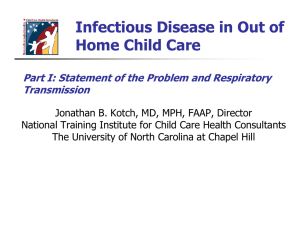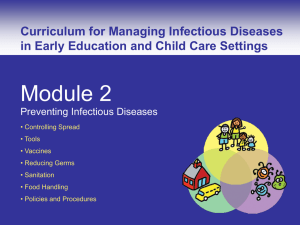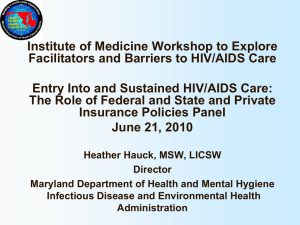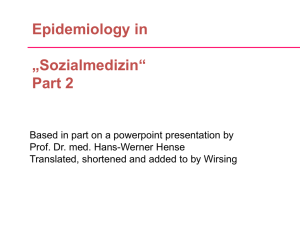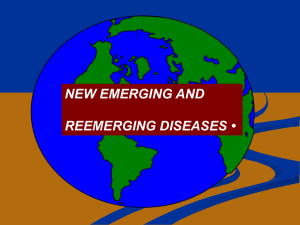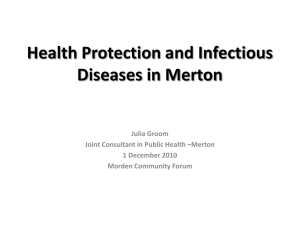Understanding Infectious Diseases
advertisement
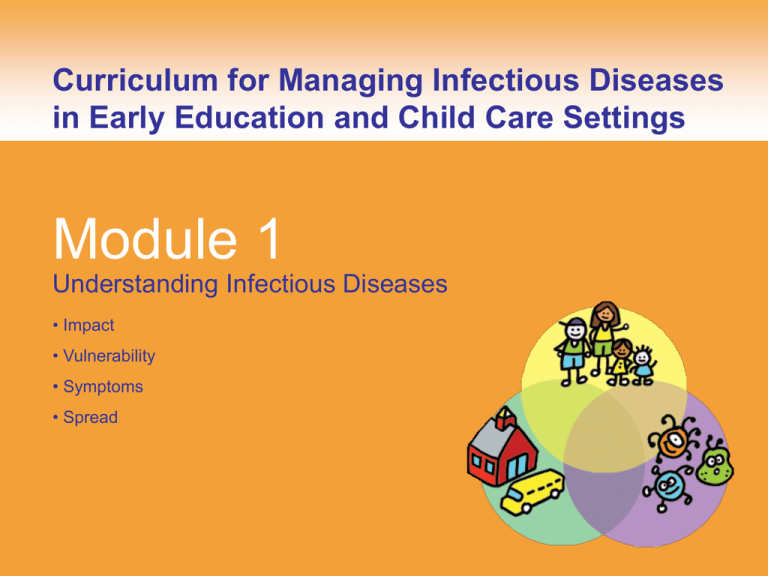
Curriculum for Managing Infectious Diseases– Module 1 Curriculum for Managing Infectious Diseases in Early Education and Child Care Settings Module 1 Understanding Infectious Diseases • Impact • Vulnerability • Symptoms • Spread Curriculum for Managing Infectious Diseases– Module 1 Types of Germs • Virus – Frequently get better on their own – Limited treatment, other than rest and control of symptoms – Few medications to treat viruses • Bacteria – Often need to be treated with antibiotics • Fungus – Often on surfaces of body and can be treated with creams or oral medication • Parasite – Typically cause diarrhea – Often need to be treated with antiparasitic medications Curriculum for Managing Infectious Diseases– Module 1 Definitions • Infection – When a germ causes a disease • Contamination – When a germ is placed in or on the body, a surface, or in food or water Curriculum for Managing Infectious Diseases– Module 1 More Definitions • Contagious – When germs can be spread to others • Infectious – Capable of causing an infection • Communicable – Can be transmitted to others Essentially all mean the same thing Curriculum for Managing Infectious Diseases – Module 1 Child Care at 2:00 pm A 20-month-old child wakes up from a nap and is flushed. She does not want to play with other children and is irritable. Her temperature was taken and is 101°F. • How does this affect: –Parents? –Caregivers/teachers at the center? –Health care professionals? • How will the impact influence their decision making? Curriculum for Managing Infectious Diseases– Module 1 Impact of Infectious Diseases • Economic – Loss of revenue for the family – Loss of productivity for the employer • Contagion – Other children in child care – Families – Caregivers/teachers and their families • Disruption – Alternative caregivers – Other colleagues filling in for missing parent at work • Health care – Many office visits to get “sick notes” – Inappropriate use of antibiotics – Added responsibility of administering medication in child care Curriculum for Managing Infectious Diseases – Module 1 Impact of Infectious Diseases • All members of society are affected Curriculum for Managing Infectious Diseases– Module 1 Bad News: Illness Frequency Children in early education and child care • Sick more often • Illnesses last longer • More ear infections and are more likely to have tympanostomy tubes placed • More antibiotic-resistant bacterial infections Curriculum for Managing Infectious Diseases – Module 1 Incidence of illness Good News: Annual Illness Incidence by Age Age of child Curriculum for Managing Infectious Diseases– Module 1 More Good News • Germs in early education programs are the same as those in community outbreaks • 90% of infections are mild, self-limited, and require no treatment Curriculum for Managing Infectious Diseases– Module 1 Good News for Child Care • Illness incidence decreases after the first full year of attendance • Kindergarteners with prior early education program attendance have fewer infections • Children who attended early education programs were less likely to develop asthma at 6 years of age Curriculum for Managing Infectious Diseases – Module 1 Why Are Children More Vulnerable to Infectious Diseases? Curriculum for Managing Infectious Diseases– Module 1 Who is Most Vulnerable to Infection? • Young infants • Children with special health care needs – Equipment in their bodies (catheters, g-tubes) • Children with impaired immune systems • Pregnant women Curriculum for Managing Infectious Diseases – Module 1 Symptoms of Infectious Diseases • What symptoms might this child have or develop in the next few days? Curriculum for Managing Infectious Diseases– Module 1 Symptoms of Infectious Diseases • • • • • • • • • • • • • Cough Runny nose and/or congestion Difficult or noisy breathing Vomiting, nausea, or stomachache Diarrhea Rash Itching Drainage or irritation of eye or other infected body part Fever Aches or pains: Sore throat, earache, headache, body ache Mouth sores Swollen glands Behavior changes Curriculum for Managing Infectious Diseases – Module 1 Common Symptoms Reported in Early Education Settings Respiratory 66% Fever 14% Gastroenteritis 9% Rash 5% Earache 6% Curriculum for Managing Infectious Diseases – Module 1 Symptoms That Cause The Most Absence Curriculum for Managing Infectious Diseases– Module 1 How Infectious Diseases Spread • Respiratory droplets • Fecal-oral • Direct contact with people or objects (especially by germs on hands) • Body fluids: blood, urine, and saliva • Insects Curriculum for Managing Infectious Diseases– Module 1 Bingo Matching Exercise • Pull out your blank bingo card • In random order on your card, fill in the squares with these methods of how infectious diseases are spread – – – – – Direct Contact 1 Fecal-Oral 1 Body Fluids 1 Insects Respiratory _ Direct Contact 2 _ Fecal-Oral 2 _ Body Fluids 2 _ Free Space Curriculum for Managing Infectious Diseases– Module 1 Bingo Matching Exercise • We will be projecting photos of ways to spread disease • Match the photo with the way it spreads disease • Call out if you get BINGO! Curriculum for Managing Infectious Diseases – Module 1 Curriculum for Managing Infectious Diseases – Module 1 Curriculum for Managing Infectious Diseases – Module 1 Curriculum for Managing Infectious Diseases – Module 1 Curriculum for Managing Infectious Diseases – Module 1 Curriculum for Managing Infectious Diseases – Module 1 Courtesy of Public Health Image Library (PHIL), CDC Curriculum for Managing Infectious Diseases – Module 1 Curriculum for Managing Infectious Diseases – Module 1 Curriculum for Managing Infectious Diseases – Module 1 Curriculum for Managing Infectious Diseases – Module 1 Curriculum for Managing Infectious Diseases– Module 1 Summary • All members of society are affected by the spread of infectious diseases in groups of children • Children are more vulnerable because of immature immune systems • Infectious diseases spread by different methods • Each method of spread can be prevented by specific strategies, which will be discussed in the next module Questions? Curriculum for Managing Infectious Diseases– Module 1 References • • • • • • • • • • • Carabin H, Gyorkos TW, Soto JC, Penrod J, Joseph L, Collet J. Estimation of direct and indirect costs because of common infections in toddlers attending day care centers. Pediatrics; 1999:103(3):556–564 (Slide 6) Heymann SJ, Earle A, Egleston B. Parental availability for the care of sick children. Pediatrics. 1996:98(2): 226–230 (Slide 6) Skull SA, Ford-Jones EL, Kulin NA, Einarson TR, Wang EEL. Child care center staff contribute to physician visits and pressure for antibiotic prescription. Arch Pediatr Adolesc Med. 2000;154:180–183 (Slide 6) Wald ER, Guerra N, Byers C. Frequency and severity of infections in day care: three-year follow-up. J Pediatr. 1991;118:509–514 (Slide 8) Holmes, SJ, Morrow, AL, Pickering, LK. Child-care practices: effects of social change on the epidemiology of infectious diseases and antibiotic resistance. Epidemiologic Review. 1996;18:10–28 (Slide 8) Cordell RL, Waterman SH, Chang A, et al. Provider-reported illness and absence due to illness among children attending child-care homes and centers in San Diego, Calif. Arch Pediatric Adolescent Medicine. 1999;153:275–280 (Slides 9, 16, 17) Hurwitz ES, Gunn WJ, Pinsky PF, et al. Risk of respiratory illness associated with day-care attendance: a nationwide study. Pediatrics. 1991;87:62–69 (Slide 11) Collet JP, Burtin P, Bossard N, et al. Type of day-care setting and risk of repeated infections. Pediatrics. 1994;94:997–999 (Slide 11) McCutcheon H, Woodward A. Acute respiratory illness in the first year of primary school related to previous attendance at child care. Australian and New Zealand Journal of Public Health. 1996;20:49–53 (Slide 11) Ball TM, Holberg CJ, Aldous MB, Martinez FD, Wright AL. Influence of attendance at day care on the common cold from birth through 13 years of age. Arch Pediatric Adolescent Medicine. 2002; 156:121–126 (Slide 11) Ball TM, Castro-Rodriguez JA, Griffith KA, et al. Siblings, day-care attendance, and the risk of asthma and wheezing during childhood. New England Journal of Medicine. 2000;343: 538–543 (Slide 11)
